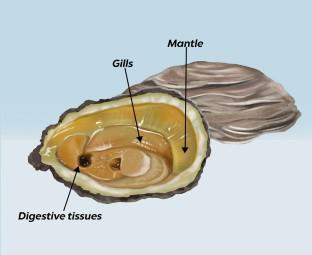Food and Environmental Virology ( IF 3.4 ) Pub Date : 2022-10-26 , DOI: 10.1007/s12560-022-09538-9 Vilaine Corrêa da Silva 1 , Mariana Elois 1 , Beatriz Pereira Savi 1 , Marília Miotto 2 , Juliano De Dea Lindner 2 , Gislaine Fongaro 1 , Doris Sobral Marques Souza 1, 2

|
Oysters are filter-feeders and retain sewage-derived pathogens in their organs or tissues. Since most enteric viruses involved in outbreaks cannot grow in cell culture, studies using viral surrogate models are essential. Some species are proposed as surrogates for enteric viruses in environmental samples, including in bivalve mollusk samples, such as murine norovirus type 1 (MNV-1) and somatic (as φX) or F-specific coliphages (as MS2) bacteriophages. This study evaluated the tissue distribution of viral surrogates for enteric virus contamination after their bioaccumulation by Crassostrea gigas. Oyster tissues were analyzed for the distribution of viral surrogates (MNV-1, φX-174, and MS2) in digestive tissue (DT), gills (GL), and mantle (MT) after 4, 6, and 24 h of experimental bioaccumulation. MNV-1 had higher counts at 6 h in DT (1.2 × 103 PFU/g), followed by GL and MT (9.5 × 102 and 3.8 × 102 PFU/g, respectively). The bacteriophage φX-174 had a higher concentration in the MT at 4 and 6 h (3.0 × 102 PFU/g, in both) and MS2 in the GL after 24 h (2.2 × 102 PFU/g). The bioaccumulation pattern of MNV-1 by oysters was similar to the other enteric viruses (more in DT), while that of phages followed distinct patterns from these. Since the MNV-1 is bioaccumulated by C. gigas and is adapted to grow in cell culture, it is an important tool for bioaccumulation and viral inactivation tests in oysters. Although bacteriophage bioaccumulation was not similar to enteric viruses, they can be indicated for viral bioaccumulation analysis, analyzing MT and GL, since they do not bioaccumulate in DT.
中文翻译:

拟作为环境样品中肠道病毒污染替代品的巨牡蛎病毒的生物蓄积动态
牡蛎是滤食动物,会在其器官或组织中保留源自污水的病原体。由于涉及暴发的大多数肠道病毒不能在细胞培养中生长,因此使用病毒替代模型进行研究至关重要。一些物种被提议作为环境样本中肠道病毒的替代品,包括双壳类软体动物样本,例如小鼠诺如病毒 1 型 (MNV-1) 和体细胞(如 φX)或 F 特异性大肠杆菌噬菌体(如 MS2)噬菌体。本研究评估了被Crassostrea gigas 生物蓄积后肠道病毒污染的病毒替代物的组织分布. 在实验性生物积累 4、6 和 24 小时后,分析了牡蛎组织中消化组织 (DT)、鳃 (GL) 和外套膜 (MT) 中病毒替代物(MNV-1、φX-174 和 MS2)的分布. MNV-1 在 DT 中的 6 小时计数更高(1.2 × 10 3 PFU/g),其次是 GL 和 MT(分别为 9.5 × 10 2和 3.8 × 10 2 PFU/g)。噬菌体 φX-174 在 4 小时和 6 小时在 MT 中具有更高的浓度(两者均为 3.0 × 10 2 PFU/g),在 24 小时后在 GL 中具有更高的浓度(2.2 × 10 2 PFU/g)。牡蛎对 MNV-1 的生物蓄积模式与其他肠道病毒(在 DT 中更多)相似,而噬菌体的生物蓄积模式与这些截然不同。由于 MNV-1 是由C. gigas生物累积的并且适合在细胞培养中生长,它是牡蛎生物蓄积和病毒灭活试验的重要工具。尽管噬菌体生物蓄积与肠道病毒不同,但它们可用于病毒生物蓄积分析,分析 MT 和 GL,因为它们不会在 DT 中生物蓄积。



























 京公网安备 11010802027423号
京公网安备 11010802027423号